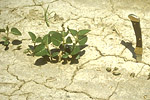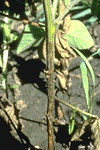Anne E. Dorrance
Assistant Professor, Department of Plant Pathology, The Ohio State University, Wooster, OH. dorrance.1@osu.edu
Steven St. Martin
Professor, Department of Horticulture and Crop Science, The Ohio State University, Columbus, OH. stmartin+@osu.edu
Dorrance, A.E. and St. Martin, S. 2000.Phytophthora sojae: Is it time for a new approach? APSnet Features. Online. doi: 10.1094/APSnetFeature-2000-0700B
Diseases caused by Phytophthora sojae are becoming, once again, a limiting factor in soybean production in the Midwest and in some regions in the South. Warm temperatures and saturated soils are the environmental conditions that favor infection by P. sojae and disease development. Soybean plants can be attacked at all ages and may result in damping off and root and stem rot (Figures 1 and 2). P. sojae has a gene-for-gene interaction with soybean, in that for every resistance gene (designated Rps) there is a complementary gene in P. sojae for virulence or avirulence. When a P. sojae avirulence gene interacts with a soybean Rps gene an incompatible or resistant interaction occurs
.
 |
 |
 |
Figure 1. Post emergence
damping off caused by Phytophthora sojae. |
Figure 2. Stem rot of soybean caused by Phythophthora soyae. |
Figure 3. Field planted to
soybeans with severe symptoms of pre-emergence damping off caused by Phythophthora soyae. |
|


Figure 4. Soybean seedlings following inoculation with a race of Phytophthora sojae, seedling on the left is resistant and the seedling on the right is susceptible. |
|
A race of P. sojae is designated by an isolate’s reaction on eight of the known 13 Rps genes in soybeans. To determine a race, differentials, each containing one Rps gene, are inoculated with macerated mycelium of P. sojae inserted into a wound made in the hypocotyl. The reaction of the soybean plant is rated 2 to 5 days later as susceptible or resistant. A resistant reaction will appear as a healed wound and a susceptible reaction will appear as a lesion with the seedling subsequently dying.
Historically, P. sojae was first identified as a soybean pathogen in the 1950's in Indiana, Ohio and North Carolina. Resistance (Rps1) was also identified at this time and incorporated into commercial cultivars (ie: Harosoy 63 and Amsoy 71). As resistance has been deployed, new races or pathotypes of P. sojae have developed. Specifically in Ohio, during surveys in 1978-1980, P. sojae race 3 (vir 1a, 7), race 7 (vir 1a, 3a, 7), and race 9 (vir 1a, 6, 7) were the predominant races. During 1991, from 88 field samples it was determined that races 3, 7, 9 predominated, but 18 races, all with virulence towards Rps-1k, were also identified. In preliminary surveys in 1997, from 16 locations in Ohio, an additional 14 new races were identified that also had virulence to Rps-1k. P. sojae races that have compatible interactions with many of the deployed Rps genes have been identified in many of the midwest states (Abney et al., 1997; Leitz et al., 2000; Yang et al., 1996).
New sources of Rps resistance have been sought. There have been several reports in which soybean germplasm from China and South Korea have been evaluated for Rps genes and some potential candidates have been identified. However, the number of Rps genes, where they are located on the soybean chromosome in relation to other Rps genes has yet to be determined (Dorrance and Schmitthenner, unpublished; Kyle et al., 1998; Lohnes et al., 1996).
Single gene resistance has been somewhat "durable" at some level because soybean producers have been planting cultivars with only a few Rps genes and these genes have been effective for 8 to 15 years (Schmitthenner, 1985). The longevity of Rps resistance may be due to the nature of soil-borne diseases, the dynamics of infection, subsequent inoculum production and dissemination are limited within the soil environment. There have been questions regarding the role of secondary inoculum in epidemic development within any given season. For disease management purposes, we treat this disease as monocylic disease and focus our management efforts on the inoculum that is present at planting. Most fields in Ohio have adequate inoculum levels present to initiate an epidemic (Miller et al., 1997). However, with the effectiveness of single gene resistance in question in many regions of the United States other types of resistance are needed.
Partial resistance, (also termed field resistance, rate-reducing resistance, general resistance, or tolerance), has been shown to be effective against all races of P. sojae (Tooley and Grau, 1982; Schmitthenner, 1985). In soybeans with partial resistance, some root rot develops, but is limited (Tooley and Grau, 1982; Schmitthenner, 1985). This resistance is also thought to be rate-limiting (Tooley and Grau, 1982; 1984a; 1984b). Partial resistance in a number of host pathogen interactions can be divided into components, ie. specific attributes of the resistance such as reduced number of infection sites, reduced lesion expansion, longer time period for fungal reproductive structures to form as well as reduced sporulation (Parlevliet, 1979).
The primary component of partial resistance to P. sojae was the ability to restrict fungal colonization of the plant tissue (Tooley and Grau, 1984a). Tooley and Grau (1984a) reported from field evaluations, that area under the disease progress curve, simple interest infection rate, and disease incidence at growth stages V7 (late vegetative) and R5 (beginning seed development) differentiated soybean cultivars with varying degrees of rate-reducing resistance. In addition, they found that differences in yield among cultivars in P. sojae infested soil could be attributed to the degree of rate-reducing resistance present in the cultivar (Tooley and Grau, 1984b). In studies with other soybean lines there is evidence that partial resistance is highly heritable and a quantitative trait (Buzzell and Anderson, 1982; St.Martin and Dorrance, unpublished; Walker and Schmitthenner, 1984). In addition, St. Martin et al. (1994) reported that partial resistance [tolerance] should not negatively impact yield potential of soybean cultivars.
|


Figure 5. Greenhouse evaluations of soybean cultivars with various levels of partial resistance, plants from left to right are scored as follows: Control, 3.5, 4.5 and 6 on a scaled of 1 to 9, in which 1=no visible root rot and 9=all plants are dead. |
|
Currently, partial resistance is identified by challenging soybean lines with a single compatible (susceptible interaction) race to determine the amount of the soybean plant that is colonized. In greenhouse assays, approximately 30% of the roots are colonized by P. sojae in soybean cultivars with high levels of partial resistance. Soybean plant introductions with very high levels of partial resistance may contain other types of resistance that cannot be identified with these methods. There are reports from Ohio, Maryland and Australia in which races of P. sojae have adapted to cultivars which were believed to have high levels of partial resistance(<20% roots colonized), but were subsequently identified as single major genes expressed in the roots (McBlain et al., 1991; Ryley et al., 1998; Thomison et al., 1988; Thomison et al., 1991).
A characterization of the reaction caused by Rps2 and other soybean lines that have a high degree of partial resistance, or potentially other single major genes for resistance, is necessary in order to avoid selecting for these single genes. Field evaluations in an area conducive to infection and subsequent disease development with a diversity of races of P. sojae is warranted.
Buzzell and Anderson (1982) proposed that selection for partial resistance [tolerance] combined with Rps genes would in fact provide long-term disease control of P. sojae in soybeans. In order to preserve potentially novel Rps genes they should ultimately be used in combination with partial resistance. However, it is necessary to identify how soybean cultivars, plant introductions and populations with high levels of partial resistance limit disease development under field situations with a diverse population of P. sojae. This will enhance our efforts to determine specific components of partial resistance that limit disease development in the field and will greatly assist in the rapid development, deployment and appropriate utilization of this type of resistance.
References Cited
Abney, T. S., Melgar, J. C., Richards, T. L., Scott, D. H., Grogan, J., and Young, J. 1997. New races of Phytophthora sojae with Rps1-d virulence. Plant Dis. 81:653-655.
Buzzell, R.I. and Anderson, T.R. 1982. Plant loss response of soybean cultivars to Phytophthora megasperma f.sp. glycinea under field conditions. Plant Dis. 66:1146-1148.
Diers, B. W., Mansur, L., Imsande, J. and Shoemaker, R. C. 1992. Mapping Phytophthora resistance loci in soybean with restriction fragment length polymorphism markers. Crop Sci. 32:377-383.
Kyle, D.E., Nickell, C.D., Nelson, R.L., and Pedersen, W.L. 1998. Response of soybean accessions from provinces in southern China to Phytophthora sojae. Plant Dis. 82:555-559.
Leitz, R.A., Hartman, G.L., Pederson, W.L. and Nickell, C.D. 2000. Races of Phytophthora sojae in Illinois. Plant Dis. 84:487.
Lohnes, D.G., Nickell, C. D., and Schmitthenner, A. F. 1996. Origin of soybean alleles for Phytophthora resistance in China. Crop Sci. 36:1689-1692.
McBlain, B. A., Zimmerly, M. M., Schmitthenner, A. F. and Hacker, J. K. 1991. Tolerance to Phytophthora rot in soybean: I. Studies of the cross >Ripley= x >Harper=. Crop Sci. 31:1405-
1411.
Miller, S.A., Madden, L.V. and Schmitthenner, A.F. 1997. Distribution of Phytophthora spp. in field soils determined by immunoassay. Phytopathol. 87:101-107.
Parlevliet, J. E. 1979. Components of resistance that reduce the rate of epidemic development. Ann. Rev. Phytopathol. 17:203-222.
Ryley, M. J., Obst, N. R., Irwin, J A. G., and Drenth, A. 1998. Changes in the racial composition of Phytophthora sojae in Australia between 1979 and 1996. Plant Dis. 82:1048-1054.
Schmitthenner, A. F. 1985. Problems and progress in control of Phytophthora root rot of soybean. Plant Dis. 69:362-368.
St. Martin, S. K., Scott, D. R., Schmitthenner, A. F., and McBlain, B. A. 1994. Relationship between tolerance to Phytophthora rot and soybean yield. Plant Breeding 113:331-334.
Thomison, P. R., Thomas, C. A., and Kenworthy, W. J. 1991. Tolerant and root resistant soybean cultivars: Reactions to Phytophthora rot in inoculum-layer tests. Crop Sci. 31:73-75.
Thomison, P R., Thomas, C. A., Kenworthy, W. J. and McIntosh, M. S. 1988. Evidence of pathogen specificity in tolerance of soybean cultivars to Phytophthora rot. Crop Sci. 28:714-715.
Tooley, P.W. and Grau, C.R. 1982. Identification and quantitative characterization of rate-reducing resistance to Phytophthora megasperma f.sp. glycinea in soybean seedlings. Phytopathol. 72:727-733.
Tooley, P.W. and Grau, C. R. 1984a. Field characterization of rate-reducing resistance to Phytophthora megasperma f. sp. glycinea in soybean. Phytopathol. 74:1201-1208.
Tooley, P.W. and Grau, C. R. 1984b. The relationship between rate-reducing resistance to Phytophthora megasperma f.sp. glycinea and yield of soybean. Phytopathol. 74:1209-1216.
Walker, A. K. and Schmitthenner, A. F. 1984. Heritability of tolerance to Phytophthora rot in soybean. Crop Sci. 24:490-491.
Yang, X.B., Ruff, R.L., Meng, X.Q., and Workneh, F. 1996. Races of Phytophthora sojae in Iowa soybean fields. Plant Dis. 80:1418-1420.
RETURN TO APSnet FEATURE STORY